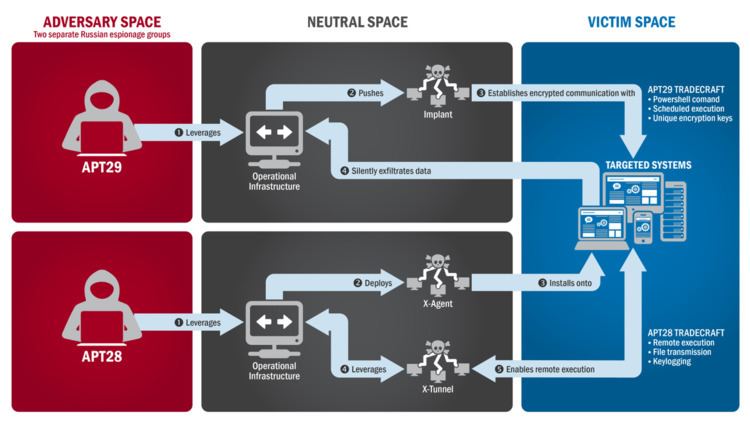Formation c. 2008 | ||
 | ||
Type Advanced persistent threat Purpose Cyberespionage, cyberwarfare | ||
Cozy Bear, classified as advanced persistent threat APT29, is a Russian hacker group believed to be associated with Russian intelligence. Cybersecurity firm CrowdStrike has suggested that it may be associated with either the Russian Federal Security Service (FSB) or Foreign Intelligence Service (SVR). The group was given other nicknames by other cybersecurity firms, including Office Monkeys, CozyCar, The Dukes (by Volexity), and CozyDuke (by F-Secure).
Contents
Methods and technical capability
Kaspersky Lab determined that the earliest samples of Miniduke are from 2008. The original Miniduke malware was written in assembler. Symantec believes that Cozy Bear had been compromising diplomatic organizations and governments since at least 2010. Cozy Bear appears to have different projects, with different user groups. The focus of its project "Nemesis Gemina" is military, government, energy, diplomatic and telecom sectors.
The CozyDuke malware utilises a backdoor and a dropper. The malware exfiltrates data to a command and control server. Attackers may tailor the malware to the environment. The backdoor components of Cozy Bear's malware are updated over time with modifications to cryptography, trojan functionality, and anti-detection. The speed at which Cozy Bear develops and deploys its components is reminiscent of the toolset of Fancy Bear, which also uses the tools CHOPSTICK and CORESHELL.
Cozy Bear's CozyDuke malware toolset is structurally and functionally similar to second stage components used in early Miniduke, Cosmicduke, and OnionDuke operations. A second stage module of the CozyDuke malware, Show.dll, appears to have been built onto the same platform as OnionDuke, suggesting that the authors are working together or are the same people. The campaigns and the malware toolsets they use are referred to as the Dukes, including Cosmicduke, Cozyduke, and Miniduke. CozyDuke is connected to the MiniDuke and CosmicDuke campaigns, as well as to the OnionDuke cyberespionage campaign. Each threat group tracks their targets and use toolsets that were likely created and updated by Russian speakers. Following exposure of the MiniDuke in 2013, updates to the malware were written in C/C++ and it was packed with a new obfuscator.
Cozy Bear is suspected of being behind the 'HAMMERTOSS' remote access tool which uses commonly visited websites like Twitter and GitHub to relay command data.
Seaduke is a highly configurable, low-profile Trojan only used for a small set of high-value targets. Typically, Seaduke is installed on systems already infected with the much more widely distributed CozyDuke.
Attacks
Evidence suggests that Cozy Bear's targets have included commercial entities and government organizations in Germany, Uzbekistan, and South Korea. It is believed to have also targeted the US State Department and the White House in 2014.
Office monkeys (2014)
In March 2014, a Washington, D.C.-based private research institute was found to have Cozyduke (Trojan.Cozer) on their network. Cozy Bear then started an email campaign attempting to lure victims into clicking on a flash video of office monkeys that would also include malicious executables. By July the group had compromised government networks and directed Cozyduke-infected systems to install Miniduke onto a compromised network.
Pentagon (August 2015)
In August 2015 Cozy Bear was linked to a spear-phishing cyber-attack against the Pentagon email system causing the shut down of the entire Joint Staff unclassified email system and Internet access during the investigation.
Democratic National Committee (2016)
In June 2016, Cozy Bear was implicated alongside the hacker group Fancy Bear in the Democratic National Committee cyber attacks. While the two groups were both present in the Democratic National Committee's servers at the same time, they appeared to be unaware of the other, each independently stealing the same passwords and otherwise duplicating their efforts. A CrowdStrike forensic team determined that while Cozy Bear had been on the DNC's network for over a year, Fancy Bear had only been there a few weeks. Cozy Bear's more sophisticated tradecraft and interest in traditional long-term espionage suggest that the group originates from a separate Russian intelligence agency.
US think tanks and NGOs (2016)
After the United States presidential election, 2016, Cozy Bear was linked to a series of coordinated and well-planned spear phishing campaigns against U.S.-based think tanks and non-governmental organizations (NGOs).
Norwegian Government (2017)
On February 3, 2017, the Norwegian Police Security Service (PST) reported that attempts had been made to spearphish the email accounts of nine individuals in the Ministry of Defence, Ministry of Foreign Affairs, and the Labour Party. The acts were attributed to Cozy Bear, whose targets included the Norwegian Radiation Protection Authority, PST section chief Arne Christian Haugstøyl, and an unnamed college. Prime Minister Erna Solberg called the acts "a serious attack on our democratic institutions." The attacks were reportedly conducted in January 2017.
Dutch ministries (2017)
In February 2017, it was revealed that Cozy Bear and Fancy Bear had made several attempts to hack into Dutch ministries, including the Ministry of General Affairs, over the previous six months. Rob Bertholee, head of the AIVD, said on EenVandaag that the hackers were Russian and had tried to gain access to secret government documents.
In a briefing to parliament, Dutch Minister of the Interior and Kingdom Relations Ronald Plasterk announced that votes for the Dutch general election in March 2017 would be counted by hand.
